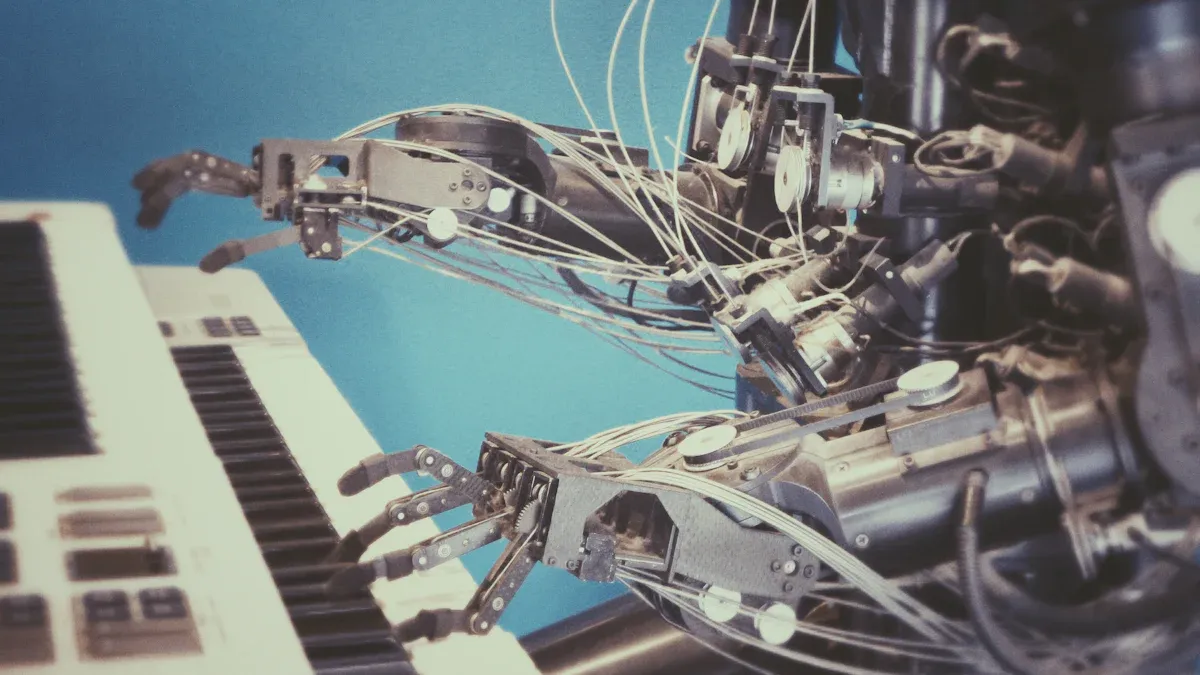
Artificial Intelligence (AI) has changed the world in many ways, showcasing the remarkable evolution of AI. You see its effects every day. It makes communication easier and improves industries. For example, WhatsApp handles over 100 billion messages daily using AI. This shows how AI helps things work faster. But AI is not just about technology. Countries use AI to study global trends and plan better strategies. Economically, nations leading in the evolution of AI gain more power. Others may depend on foreign technology. AI has become more than a helpful tool; it is now a big part of global power struggles.
How has AI grown from a cool invention to a global force?
Key Takeaways
- AI has changed industries by making work faster and smarter. Businesses now need AI to stay successful.
- Nations that spend on AI research get stronger economies. This creates a global race where AI decides who leads.
- Fixing unfairness and being clear about how AI works is key. This helps people trust and use AI fairly.
- Governments, companies, and experts must work together. They need to make good rules and get the most from AI.
- AI's future depends on teamwork and new ideas. It must follow fair rules to help everyone in a good way.
The Evolution of AI: From Idea to Reality
How AI Began in the 1950s
AI started with big ideas in the 1950s. In 1950, Alan Turing created the Turing Test. This test checked if machines could think like people. It sparked interest and became a key idea for AI. In 1956, the Dartmouth Conference was a major event. Scientists like John McCarthy named the field "Artificial Intelligence" and discussed how machines could act smart.
Thinkers like René Descartes and Ada Lovelace also inspired AI. Descartes imagined machines acting like humans. Lovelace believed machines could do more than math. These ideas helped turn AI into a real science.
Big Moments in AI’s Growth
AI’s history is full of amazing achievements. In 1957, the Perceptron introduced neural networks. These helped machines learn patterns. By 1966, ELIZA, an early chatbot, showed machines could understand language. In the 1970s and 1980s, expert systems like MYCIN solved medical problems using rules.
In 1997, IBM’s Deep Blue beat chess champion Garry Kasparov. This showed AI could handle tough tasks. In 2012, the ImageNet Challenge proved deep learning could recognize objects well. These events show how AI grew from simple tools to solving real-world problems.
Machine Learning and Neural Networks Take Over
Machine learning and neural networks made AI much stronger. In 1957, the Perceptron introduced basic neural networks to find patterns. Later, in 1992, Hinton’s Boltzmann Machine improved these networks by adding hidden layers.
The 2012 ImageNet Challenge was a game-changer. Deep learning models became very good at identifying images. Today, machine learning is used in healthcare, finance, and more. It’s now a key part of AI’s growth.
AI as a Technological Marvel
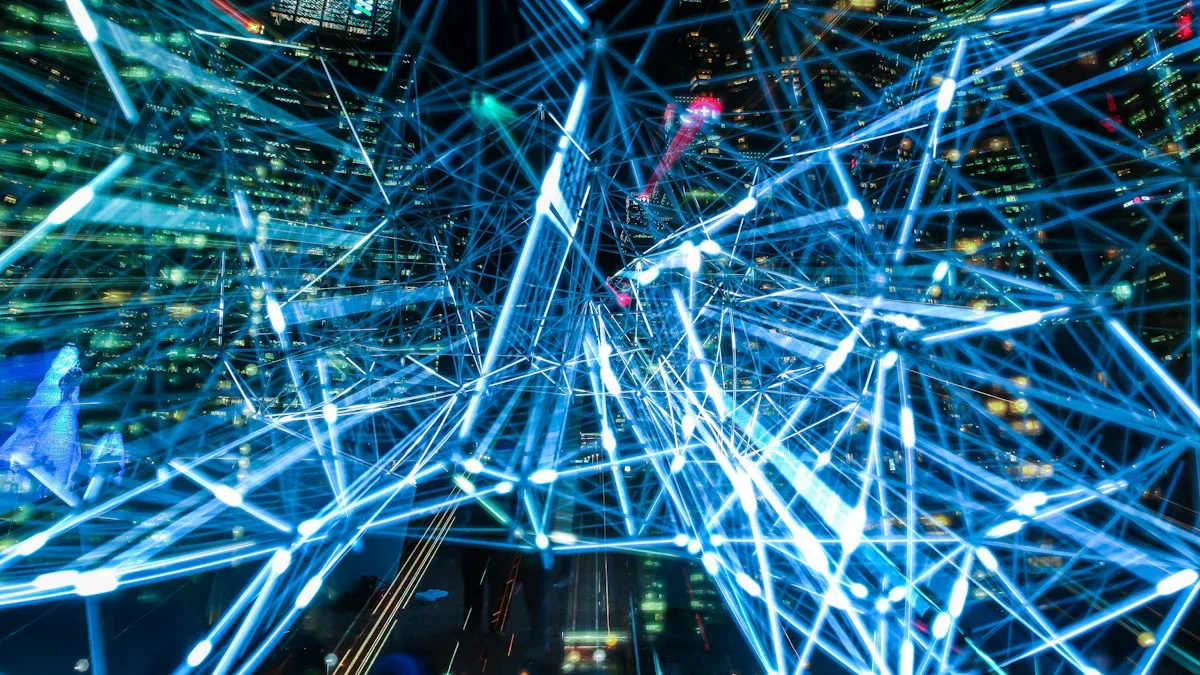
How AI Helps Different Industries
AI has changed industries by making work faster and better. In healthcare, tools like YouCOMM help nurses respond 60% faster to patients. This system is now used in five big US hospital groups. In shopping, AI gives personal suggestions, helping Edamama get $20 million in funding. Over 100,000 moms have benefited from this. In transportation, AI improves traffic flow and makes self-driving cars safer.
Companies using AI grow quickly. Tech businesses earn more money by keeping customers happy. It takes less than eight months to set up AI, so companies see results fast.
AI in Science, Medicine, and Daily Life
AI speeds up progress in science and medicine. Scientists use AI to study big data, finding new medicines and diagnosing diseases. At home, AI powers smart devices, virtual helpers, and custom suggestions, making life easier.
For example, AI tools now find diseases early and save lives. In schools, AI helps students learn better with personal lessons. These examples show how AI keeps changing the world for the better.
Fixing Early Problems in AI
Old AI systems had problems like being wrong or hard to trust. Scientists fixed this by using numbers and listening to users. For example, adding user feedback made AI tools more accurate.
By mixing data and user ideas, AI became more useful and trusted. This helped AI grow and be used by more people.
AI's Role in Global Power Dynamics
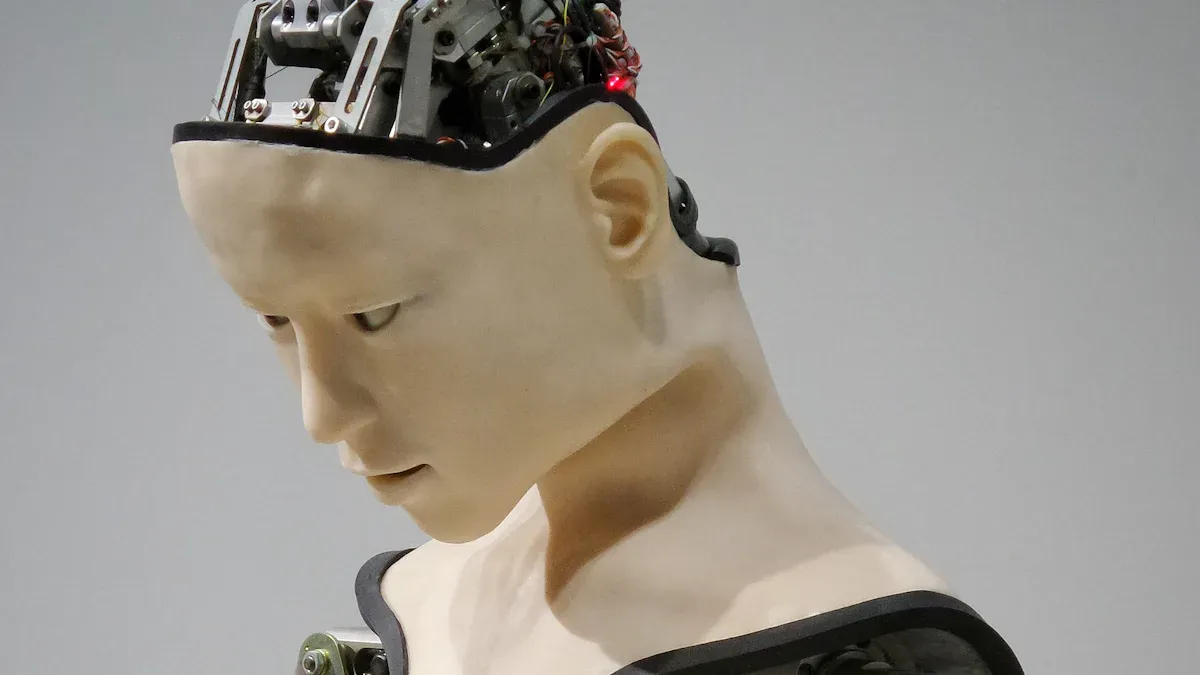
Economic Competition and the Innovation Race
AI is now a big part of global competition. Countries spending a lot on AI research get ahead. They work faster, save time, and make smarter choices with data. This helps them do better in the world market.
- AI is changing how economies work everywhere.
- Nations using AI for automation grow quicker.
- Data-based decisions boost creativity and efficiency.
The global AI market has grown quickly in recent years. The table below shows yearly growth trends:
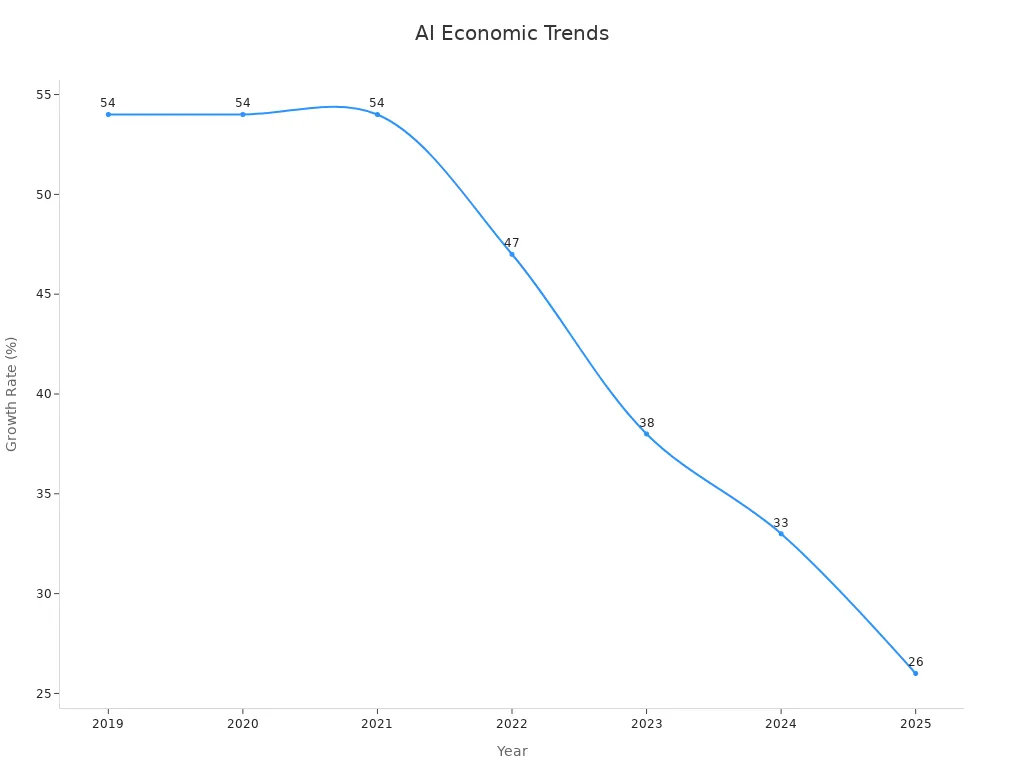
AI has also grown at a yearly rate of almost 40%. By 2026, the U.S. AI market might reach $299.64 billion. These numbers show how nations are racing to innovate.
Military Applications and Autonomous Systems
AI is changing how militaries work. It makes systems smarter, reduces mistakes, and saves time. Robots like drones and vehicles need less care. This lets people focus on important jobs.
AI also helps leaders make better choices. It studies huge amounts of data fast. This helps during tough situations. Some key uses are:
- Watching for threats and finding targets
- Training for battles and helping injured soldiers
- Protecting against cyberattacks and improving transport
These tools show how AI is changing defense plans and needing less human help.
Geopolitical Influence and Control Through AI
AI affects more than just money and defense. It is now a tool for global power. Countries with strong AI can track trends, predict changes, and shape policies.
Nations leading in AI often control global talks. They set rules for technology and manage key systems. This creates an imbalance. Countries without good AI depend on others for help.
AI has become a powerful tool. It’s not just cool technology anymore. It now shapes how countries compete and share power.
Challenges and Ethical Concerns in AI Development
Fixing Bias and Making AI Fair
AI systems can copy unfair patterns from their training data. This can cause problems in areas like jobs, loans, and justice. For example, hiring AI might favor one group over another, continuing unfair treatment. To make AI fair, we must carefully check how data is collected and used.
A USC study found bias in 38.6% of AI "facts." Women were often shown negatively, and some groups were linked to bad stereotypes. ProPublica also found that the COMPAS tool gave Black Americans higher risk scores than white ones with similar records. These examples show why fixing bias in AI is so important.
Another problem is transparency. Many AI systems work like "black boxes," hiding how they make decisions. This makes it hard to trust them, especially when they affect people's lives.
Dangers of Misuse and Unexpected Problems
AI can be used in harmful ways. One example is spreading fake news. AI can quickly share wrong information, confusing people and hurting trust in systems. You might have seen fake videos or news that caused big problems.
AI can also act in ways we don’t expect. For instance, a self-driving car might make a mistake and cause an accident. These risks show why testing and ethical rules are so important for AI.
The Global AI Race and Lack of Rules
Countries are using AI to make their militaries stronger. Nations like the US, China, and Russia use AI to plan better and save resources. But this also raises the chance of conflicts happening by mistake.
Making rules for AI is hard. Global agreements, like the G7's AI principles, don’t have strong enforcement. This lets some countries move ahead without limits. We need clear rules to stop misuse and make sure AI helps everyone.
The Future of AI and Global Collaboration
New Trends in AI Technology
AI is growing fast and changing how we live and work. Chatbots are getting better at helping customers quickly and correctly. Generative AI is creating new ways to make art and write stories. Predictive tools help businesses plan smarter by studying data patterns. Explainable AI is also important because it shows how decisions are made, building trust.
Experts are now working on agentic AI, which can team up with people to do harder jobs. This shows the need for AI that does more than simple tasks. Another big trend is the rise in AI jobs. The need for skilled workers has grown 31 times, with over 900 different AI job types now available. These trends prove AI is becoming a bigger part of daily life and work.
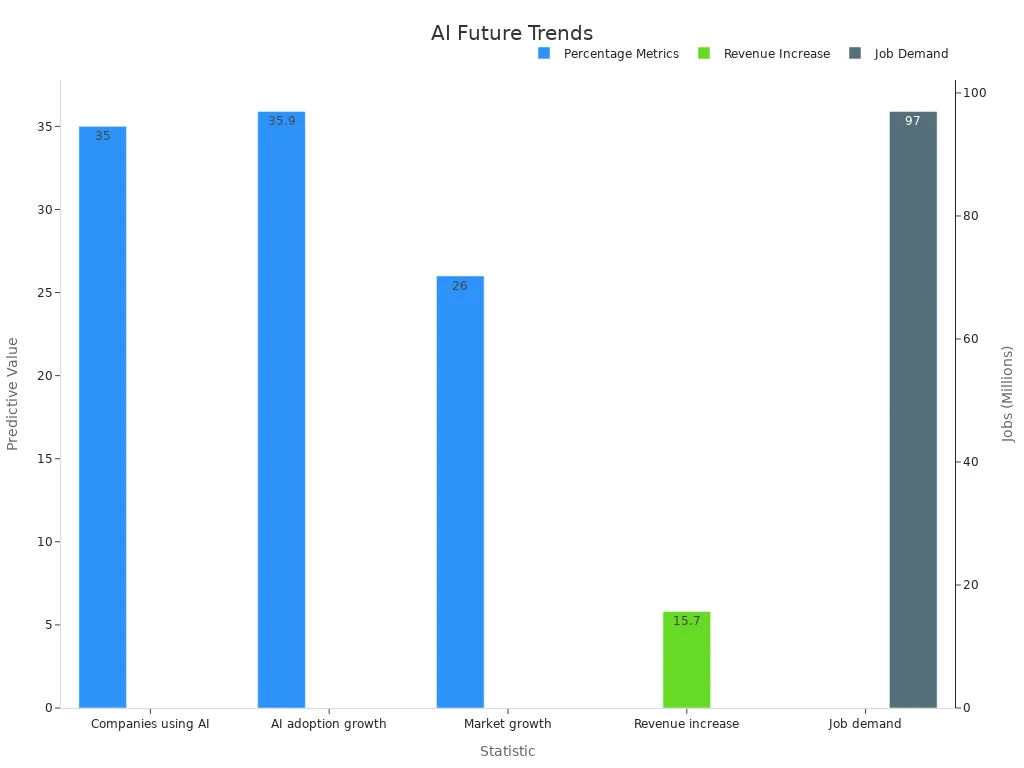
Why We Need Rules and Fair AI
AI can do amazing things, but it also has problems. Bias in AI can lead to unfair results, like favoring one group over another in hiring or justice. Some AI systems are hard to understand because they work like "black boxes." This makes people doubt them, especially in important areas like health.
Governments and companies see these problems and are taking action. The White House is making rules to guide fair AI development. Good rules are needed to make sure AI is honest, clear, and helpful. Fixing these issues will make AI better for everyone.
Working Together to Handle AI's Effects
Teamwork is key to managing AI’s global effects. Governments, businesses, and experts must join forces to create smart plans. This includes making rules, improving technology, and involving the public. A strong plan can solve the unique problems in different industries.
By working together worldwide, we can use AI safely and wisely. This teamwork lowers risks and helps everyone enjoy AI’s benefits.
AI has grown from a cool idea to a global power. It now affects how countries plan, trade, and work together. Nations with strong AI make better allies and set global rules. They also use AI to improve farming, energy, and defense, making them safer and stronger.
To use AI wisely, we must fix problems like unfairness and misuse. Countries need to work together to make fair rules. By teaming up, AI can bring new ideas, solve big problems, and make the world better for everyone.
FAQ
1. How does AI affect your everyday life?
AI makes life easier with tools like smart assistants and gadgets. It helps you shop better, plan your day, and stay healthy using fitness apps or medical tools.
2. Why is AI seen as a global power tool?
AI helps countries grow in technology, defense, and business. Nations with strong AI can lead global decisions, control markets, and improve safety, making it vital in world affairs.
3. What dangers come from AI misuse?
AI misuse can spread lies, invade privacy, or create unfair systems. For instance, fake videos or news can trick people. Following ethical rules can lower these risks and build trust.
Tip: Always check facts from AI-made content to avoid being misled.
4. How can AI be made fairer?
AI becomes fairer by fixing bias, being clear, and following rules. Developers should use varied data and explain how AI works. Governments and groups must also ensure fair practices.
5. What is the future of AI teamwork?
The future depends on working together globally. Governments, companies, and experts must join forces to create rules, share ideas, and solve big problems. Teamwork ensures AI helps everyone and reduces risks.
Note: Global teamwork can close the gap between AI leaders and smaller nations.